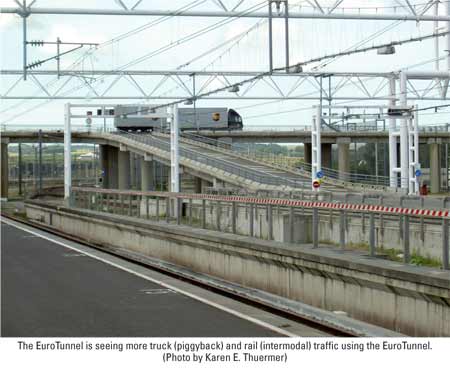By Karen E. Thuermer. AJOTNorthern Europe’s logistics landscape is changing. Despite the downturn in freight volumes due to the worldwide economic slowdown, seaports there face capacity challenges. They have little room to expand.
Airfreight volumes, which are also off, provide few solutions since this mode is expensive and inter-European moves are predominately performed by truck.

Rail has rarely offered a good option in Europe. But given the spike in energy prices this summer and the trend to become more conscientiously “green”, effort is increasing being made to turn rail into a more viable option for European shipments.
The Eurotunnel offers one solution for those moving goods between the United Kingdom and Continental Europe. While freight volumes through the “Chunnel” have rapidly declined, Charlotte Brookes, Eurotunnel’s UK spokesperson, recently admitted to this
AJOT reporter that future prospects look bright.
In-fighting between management, its high cost and safety concerns have largely turned shippers away from using the Chunnel. But efforts to improve its maintenance, create a more solid organization, and introduce better pricing schemes should result in a rapid increase in rail freight, Brookes says. In fact, projections call for an increase from 1.2 million tons in 2007 to an annual figure of three million tons—a peak amount last seen in 1997.
The Channel Tunnel, which burrows under the English Channel connecting Folkestone, England with Calais, France, was originally conceived and designed to handle 10 million tons of rail freight per year. This objective has never been attained. The peak was three million tons in 1997. The reason, officials say, was the complexity of setting up cross-border rail transport in Europe, the successive reorganization of operating structures for cross-Channel freight in the United Kingdom, the lack of competitiveness of rail versus road transport (due, especially, to the fixed cost of border infrastructures) and the financial difficulties of rail freight in France.


Late last year, however, Groupe Eurotunnel SA, along with its cross-Channel rail freight partners, reached a new comprehensive, competitive strategy to develop Open Access for all freight train operators, provide efficient processing of border controls, and simplify competitive pricing. As a result, the average toll was set at EURO 4,500 per train, with a toll per train adjusted to reflect speed and peak or quiet periods, thereby allowing operators to optimize loads.
In addition, operators were guaranteed open, efficient and fair access to freight facilities with a EURO 600 ceiling on the cost of essential cross-Channel services, such as processing border controls and the use of specialized “Class 92” cross-Channel locomotives.
In November 2007, Europorte 2, Eurotunnel Group’s freight operations subsidiary, in partnership with SNCF (the French National Railway Company), took over ground operations for cross-Channel traffic in the Calais-Frethun border zone (coupling/uncoupling, shunting, safety inspection, security controls, administration, etc.) as well as the traction of freight trains in the Tunnel.
“These measures help to make the overall cost of freight rail transport competitive compared to road haulage, and should encourage great use of trains, with corresponding pollution gains,” Brookes says.
Consequently, Eurotunnel Group officials believe this strategy gives Eurotunnel the opportunity to tap into new markets such as intermodal freight and piggybacking. Now the goal is to reach six million tons a year over time.
DELTA 3 PLATFORM
The Eurotunnel, however, offers only





